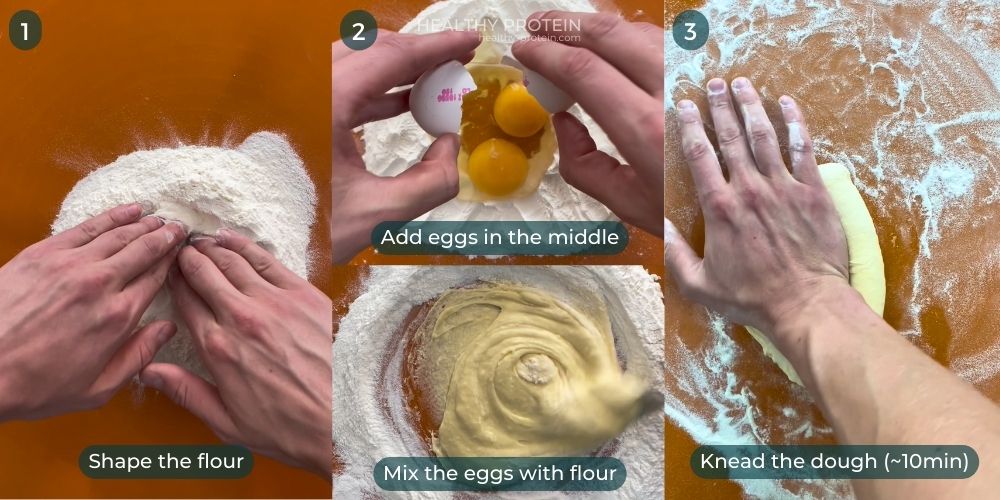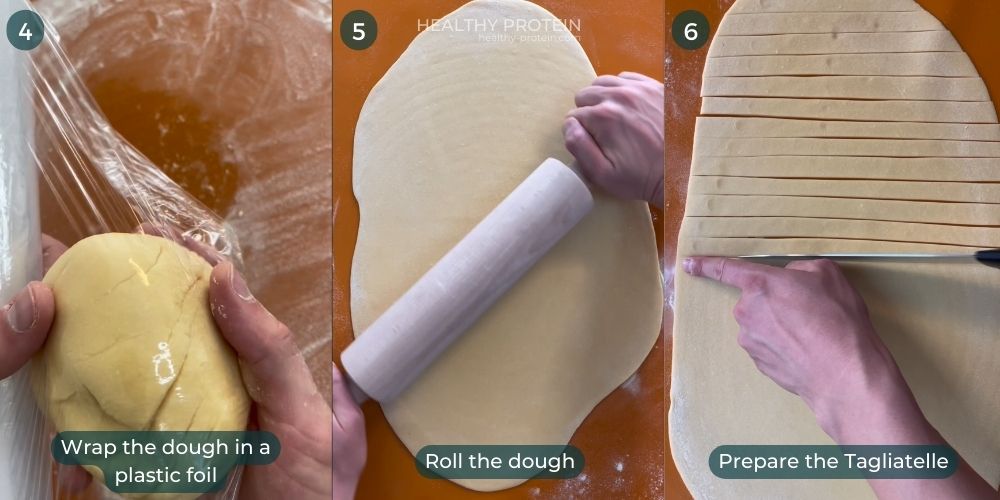Homemade Pasta Recipe (Tagliatelle) – Only 2 Ingredients
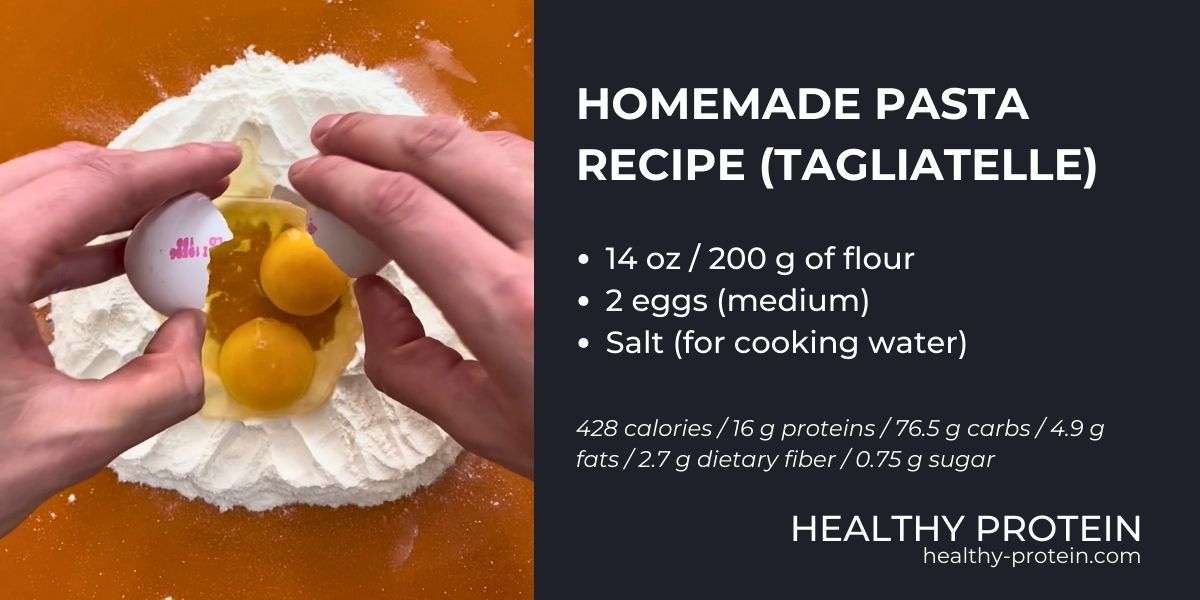
Overview
Homemade pasta recipe that is really easy to make without machine. Making your own fresh pasta at home couldn’t be easier with this simple two ingredient recipe. Buying dried pasta is convenient but making your own pasta is just so much more special and actually a lot easier than you might think.
There’s many different pasta sorts you could make with this recipe, but for this one we’ll go with the simplest and the fastest option that absolutely anybody could master – the Tagliatelle pasta.
So give it a go and test it out, because from my experience making your own pasta is a great gateway of understanding that anyone can cook and at the same time enjoy its process. This recipe is also a great and fun activity for dinner parties by letting the guests make their own pasta.
What Equipment Do You Need to Make Fresh Pasta?
- Work surface – for kneading, rolling and cutting the pasta dough. The size of the work surface depends on the amount of pasta you’ll be making. If you make just 1-2 servings, the work surface can be rather small, but for 3-4 servings, be prepared to find a larger work surface and make some space. I recommend using a larger silicone mat or any alternative on your work surface to make cleaning up easier and safer not to damage the work surface while rolling and cutting the dough.
- Fork – for whisking the eggs with flour to form a dough before kneading the dough with your hands.
- Rolling pin – for rolling the pasta dough.
- Cooking pot – for boiling the pasta.
- Any kind of knife – for cutting the shape of the Tagliatelle pasta stripes.
That’s it! Having a pasta machine or Kitchenaid is definitely a benefit, but for this recipe we’ll do it the old fashioned way by hand which anybody can simply do at home.
Ingredients for Homemade Fresh Pasta
- Flour: The most important ingredient for making pasta is flour. For this recipe I would recommend to buy plain 00 type flour. If there’s none available in your local stores, go with plain all purpose flour, which also does the job. The difference between 00 type and all purpose flour is simply that the 00 type flour has a higher consistency of protein and therefore helps to hold the pasta’s texture a bit better.
- Eggs: Personally I always try to buy free range eggs from the local farmers market, but if it’s not possible then just get any brand of your favorite eggs from your local grocery store. For this recipe it’s best to use medium or large eggs.
- Salt for seasoning the pasta water – Any kind of table, kosher or sea salt can be used in the pasta water while boiling the pasta.

How to Make Tagliatelle Pasta From Scratch?
- Place all of the flour on a clean work surface and form a volcano shaped mound with a hole/well in the middle, to break the eggs into – You’ll definitely need some room to roll the pasta, so do it on a table and make some space for it. Personally I use a large silicone mat, which I place on my table to make cleaning up easier and a safer option not to damage the work surface while kneading, rolling and cutting the dough.
- Crack the eggs in the middle of the flour mound and start whipping the eggs with a fork in a circular motion by gradually adding more flour from the edges – Repeat this until the dough gets too thick for the fork to function. Once you’re at that stage, scrape off any excess dough from the work surface and add it to your dough. Also add a bit of flour on top of the dough, so it wouldn’t stick to your hands while starting to knead it with your hands.
- Clean your hands and the work surface, sprinkle it lightly with flour and start kneading the dough for ~10 minutes, until it becomes smooth and elastic – knead the dough with one palm of your hand by folding the dough in half, then pressing on the dough, turning the dough 90 degrees and fold it again. If the dough gets too hard, you can use some water to make it softer to continue kneading. Repeat the process until the dough becomes smooth and elastic.
- Form the dough into a round shape and wrap it in plastic foil for ~15 minutes or up to ~two hours until you’re ready to use it – (anything over two hours, you can just store it in the fridge until using it for up to two days).
- Start rolling the pasta dough on a lightly floured work surface until it’s ~1/16 inch / 2mm thick and formed into a long and narrow strip of dough – It’s good to flip the dough from time to time with adding a light coating of flour if necessary.
- Prepare the Tagliatelle shapes by cutting the dough from top to bottom into ⅜ inch / 1 cm wide strips – An easy tip is to measure the strips with the width of your index finger, but be careful not to cut yourself. If you have bigger fingers, then you can use your pinky.
- Boil the pasta cooking water, add plenty of salt to the water and boil the pasta for 5-7 minutes until al dente – Be sure to stir the pasta from time to time, so it won’t stick to each other. Usually ~6 minutes cooking time always works if you manage to roll the pasta into ~1/16 inch / 2mm thickness. If it’s a bit thicker, then it might need an additional minute. To test, you can take one piece of Tagliatelle out of the water to try it at ~5 minutes of boiling, to understand if it needs more time or not. Also 5 minutes is definitely enough when you plan to mix and cook the Tagliatelle with a pasta sauce on the pan for an additional minute or two.
- Rinse the pasta water and serve the Tagliatelle on its own or mix it with any of your favorite pasta sauce.
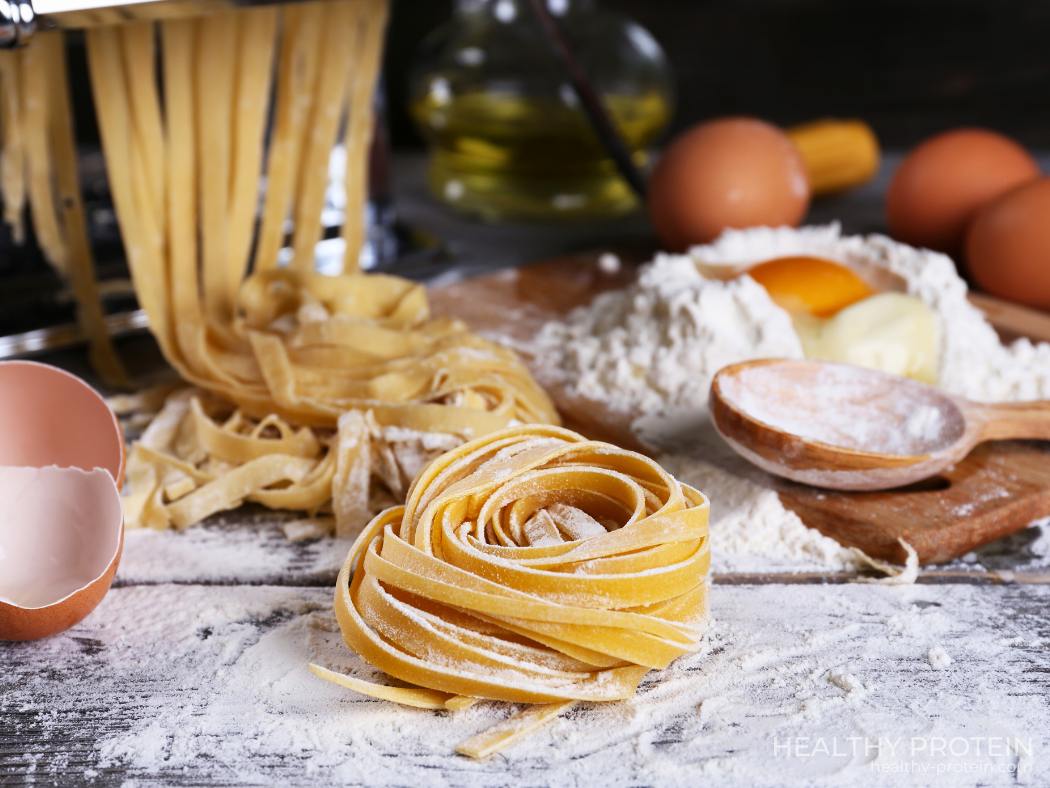
Easy Homemade Fresh Pasta Recipe (Without a Machine)
Make your own delicious fresh homemade Tagliatelle pasta with only two simple ingredients! This recipe goes perfect with any pasta sauce recipe and is an amazing idea for dinner parties.
Ingredients (2 servings)
- 14 oz / 200 g of flour (type 00 or all purpose flour)
- 2 eggs (medium)
- Salt (for the pasta cooking water)
Nutritional value per recipe (1 serving)
428 calories / 16 g proteins / 76.5 g carbs / 4.9 g fats / 2.7 g dietary fiber / 0.75 g sugar
Nutritional value per recipe (2 servings)
857 calories / 32 g proteins / 153 g carbs / 9.8 g fats / 5.4 g dietary fiber / 1.5 g sugar
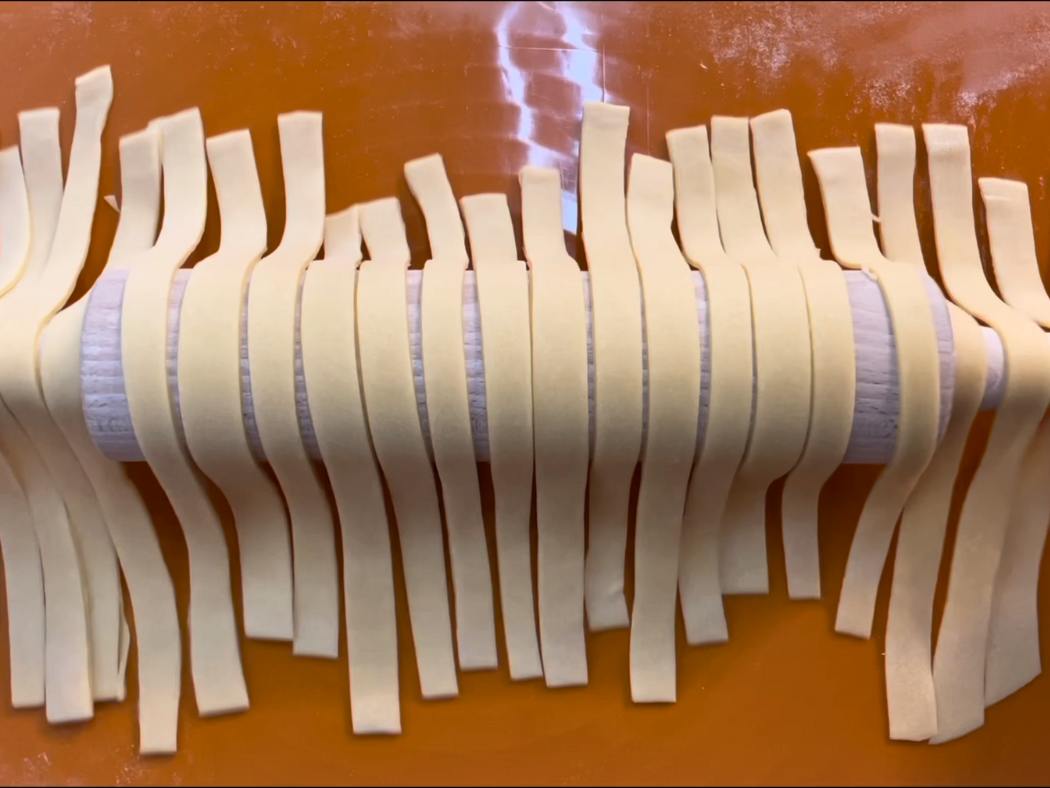
Homemade Pasta Recipe (Tagliatelle)
Equipment
- Work surface
- Fork
- Rolling Pin
- Cooking pot
Ingredients
- 14 oz flour type 00 or all purpose flour
- 2 eggs medium
- Salt for cooking water
Instructions
- Place all of the flour on a clean work surface and form a volcano shaped mound with a hole/well in the middle where to break the eggs into.
- Crack the eggs in the middle of the flour mound and start whipping the eggs with a fork in a circular motion by gradually adding more flour from the edges. Repeat this until the dough gets too thick for the fork to function. Once you’re at that stage, scrape off any excess dough from the work surface and add it to your dough and add a bit of flour on top of the dough so it wouldn’t stick to your hands while kneading it on the next step.
- Clean your hands and the work surface, sprinkle it lightly with flour and start kneading the dough for ~10 minutes until it becomes smooth and elastic. Knead the dough with one palm of your hand by folding the dough in half, then pressing on the dough, turning the dough 90 degrees and folding it again. If the dough gets too hard, you can use some water to make it softer to continue kneading. Repeat the process until the dough becomes smooth and elastic.
- Form the dough into a round shape and wrap it in plastic foil for ~15 minutes or up to ~two hours until you’re ready to cut and boil it.
- Start rolling the pasta dough on a lightly floured work surface until it’s ~1/16 inch / 2mm thick and formed into a long and narrow strip of dough.
- Cut the Tagliatelle shapes by cutting the dough from top to bottom into ⅜ inch / 1 cm wide strips of dough.
- Boil the pasta cooking water, add plenty of salt to the water and boil the pasta for 5-7 minutes until al dente. Stir the pasta from time to time so it wouldn’t stick to each other.
- Rinse the water and serve it by itself or with any of your favorite pasta sauce.
Video
Nutrition (per serving)
Tips and Myths of Cooking Pasta
Homemade pasta cooking tips and myths that might come in handy.
Should I Use Olive Oil in the Pasta Water?
The simple answer is no. Olive oil doesn’t give any benefits for cooking pasta. It is most likely a myth that olive oil doesn’t let pasta stick and makes it softer, which is actually not the case. The actual secret to not letting pasta stick to each other and to the bottom of the pan is to keep the pasta moving by stirring it as much as necessary.
What Kind of Dried Pasta Should You Buy, When You Don’t Want to Make Your Own?
If you’re buying dried pasta from the store, try to choose the sort which has egg as an ingredient included in it. Secondly if you can see through the package, try to avoid the extremely yellow colored pasta, the paler and whiter it seems, the more likely it’s a higher quality pasta. Thirdly look out for the pasta not to have too many ingredients, the less and higher quality the ingredients, the better.
How Long Does Fresh Pasta Dough Last?
Fresh pasta dough packed in an airtight container will last for up to 2 days in a fridge and up to 4 weeks in a freezer.
Should You Use Salt in the Dough or in the Pasta Cooking Water?
Never add salt to the dough, it doesn’t evenly mix throughout the kneading process and will make some parts of the pasta saltier than others. Always use salt in the pasta cooking water and don’t be afraid to add a bit more than usual, the cooking water should be basically as salty as the sea.
You may also like
